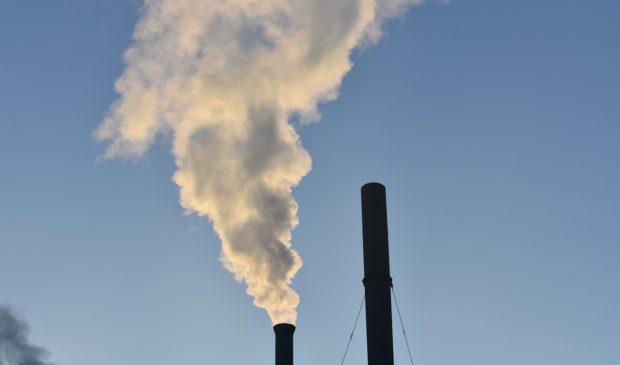Region failing to keep up with expectations of clean air
Thursday, April 11, 2019 by
Ryan Thornton The city of Austin may soon lose its standing as the largest city in the nation that is in conformity with federal air quality standards. If air quality doesn’t improve from last year, Austin and the Capital Area Metropolitan Planning Organization region risks joining the Houston and Dallas-Fort Worth regions with a “marginal non-attainment” status for unhealthy levels of ground-level ozone (O3) gas.
If the region does fall out of attainment, Andrew Hoekzema, director of regional services at the Capital Area Council of Governments, told the CAMPO Transportation Policy Board on Monday evening that the region could be proud of its efforts, like the 2004 Early Action Compact, to maintain its safe air quality, but that the consequences will likely be immediate and long-lasting.
The Environmental Protection Agency measures the region’s air quality in eight-hour segments recorded at two locations, the Audubon and the Northwest monitors, in northern and northwestern Travis County. Ranking those measurements from highest to lowest average amounts of pollution, the EPA designates the fourth-highest measurement recorded over a year’s time as that year’s design value, the number used to calculate the region’s status.
According to Walker Williamson, manager of the Air Quality Division of the Texas Commission on Environmental Quality, design values in the Austin region have steadily improved since around the year 2000, despite population growth. Since 2016, however, that trend has reversed, bringing the region directly up against the EPA’s National Ambient Air Quality Standards of 0.07 parts per million for ozone in 2017 and exceeding that limit last year with a design value of 0.072 ppm.
In determining a region’s status, Williamson said the EPA takes an average of design values from the previous three years, putting the region at risk of losing its attainment status when the EPA studies this year’s data sometime around May 2020. Williamson added that the EPA typically considers a region’s status concurrently with revising its own air quality standards every five years, but may technically do so at any time.
According to standards adopted in 2015, the EPA lists six non-attainment classifications, ranging from “marginal” at 0.071 ppm to “extreme” at 0.163 ppm and above. The consequences of a marginal status, Williamson said, are the least severe of the six classifications.
While exceeding a three-year average of 0.08 ppm (moderate non-attainment) would require a highly involved process of photochemical modeling and other analyses to find a solution, Williamson said tipping over 0.07 ppm would only increase permitting requirements for new industrial facilities, require the state to submit an emissions inventory and spark a process called transportation conformity in which regional transportation bodies like CAMPO would have to prove that any federal funds will not be spent in a way that could negatively impact regional air quality.
Hoekzema estimated that the accumulated economic setbacks resulting from even a marginal non-attainment status could cost the region as much as $42 billion in lost growth over a 25-year period.
“Those permitting requirements on new industrial facilities can have severe consequences for economic development,” Hoekzema said. “Because of the extra time required to get a non-attainment permit, Samsung would not be able to expand any more of its facility.”
Transportation conformity, Hoekzema added, is a two-decade-long process, regardless of attainment status in subsequent years. “If you want to add a lane mile to a project after it’s been approved, you have to go through that entire process to demonstrate that it’s still consistent with the air quality plan.”
As of Monday evening, Williamson said the region’s fourth-highest measurement this year is 0.055 ppm, well below the limit. As Mayor Steve Adler stated, however, the so-called “ozone season” has only just begun, with the highest levels of ground-level ozone typically produced in the hot summer months.
Because the two official monitors used by the EPA are situated close together in Travis County, County Judge Sarah Eckhardt noted that the numbers coming from them paint a prettier picture than the data of all regional air quality monitors combined. The reality, she said, is we’re “closer to non-attainment than the official monitor positions would indicate.”
Eckhardt also said the monitors’ placements make them “unlikely to pick up, for instance, the fact that about … 30 percent of our ozone-producing agents are being blown in from someplace else.” She said the Clean Air Coalition constituent members have joined forces to purchase more monitors so that the region can distinguish how much of its measured emissions are actually coming from other regions.
Hoekzema said air blowing in from other regions actually accounts for the majority of pollution in our region. “The emissions that our region adds to what is coming in from the background is maybe 16-20 parts per billion so it’s already at, say, 50 or 55 ppb, or more on high-ozone days, when it’s coming into the region.”
Adding more monitors to track that trend could help minimize the consequences of non-attainment at the federal level, Eckhardt said.
“If we were to go into non-attainment, at least we would have the statistical data to argue to the federal government that we did everything we could within our power, and our tipping over into non-attainment had more to with, say, Houston or San Antonio, than it did with us.”
The Austin Monitor’s work is made possible by donations from the community. Though our reporting covers donors from time to time, we are careful to keep business and editorial efforts separate while maintaining transparency. A complete list of donors is available here, and our code of ethics is explained here.
You're a community leader
And we’re honored you look to us for serious, in-depth news. You know a strong community needs local and dedicated watchdog reporting. We’re here for you and that won’t change. Now will you take the powerful next step and support our nonprofit news organization?











